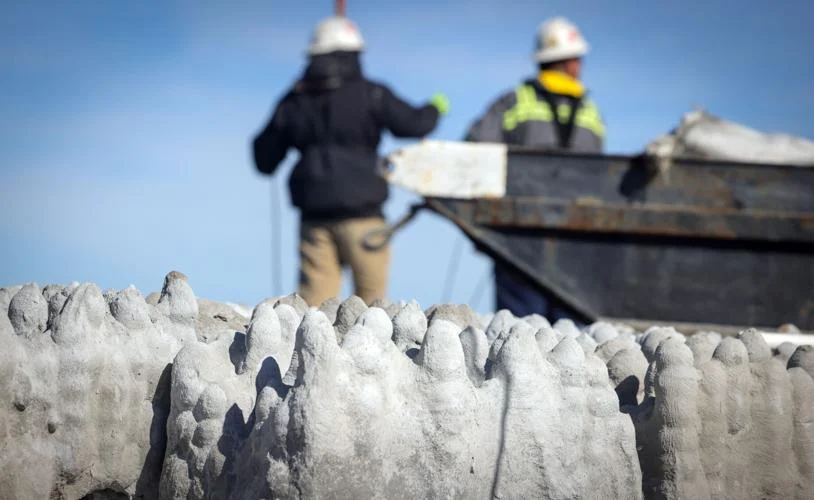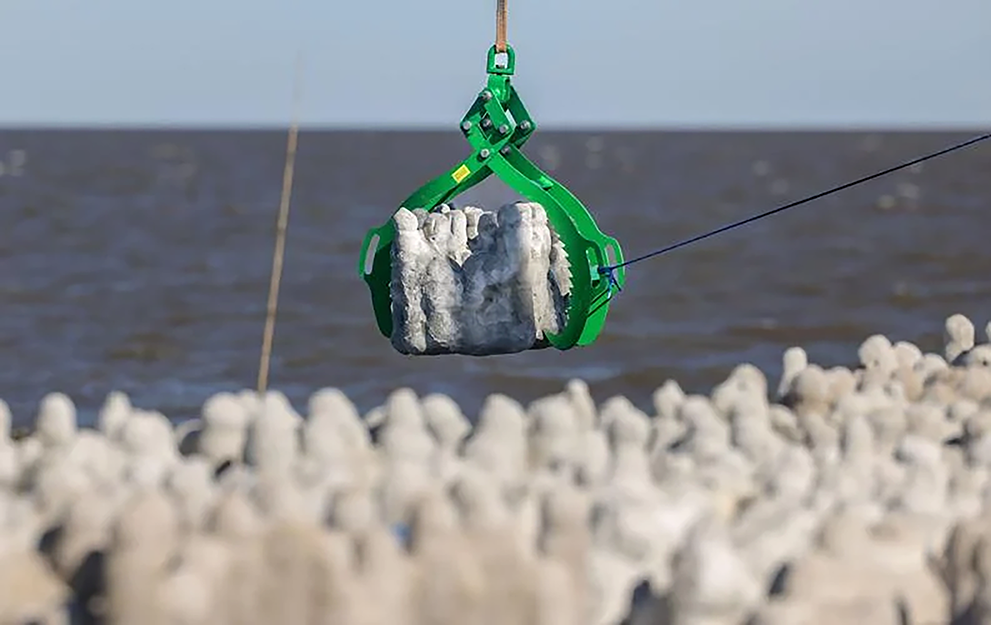
An exciting project that we recently completed with Danos and the CCA of Louisiana and the Department of Wildlife and Fisheries was recently covered by NOLA.com.
Our ExoForms™ were the ideal solution for this project in that they could be designed for the the site's shallow water (still allowing for boat access) while providing 19 square feet of oyster habitat per ExoForm. By creating new oyster habitat this project will support a healthy and productive marine life system which, in turn, will support the local fishing community. It's a great example of the ongoing positive benefits that can be generated by helping restore a system to a harmonious, natural balance. It's also one of the first projects that was serviced by our Louisiana-based Resilience Center of Excellence.
You can download our case study on the project here.
The story from NOLA.com is below (original story here):
---
3D-printed 'Cajun coral' project aims to boost Louisiana's fish and oyster habitat
Artificial reefs take shape on a sunken island near Port Fourchon

PORT FOURCHON — It looks like a collection of pale cypress knees, was made with a 3D printer and promises to be a magnet for oysters and fish.
The strange-looking artificial reef taking shape in Terrebonne Bay is a new tool that conservation and fishing groups hope will help ease habitat loss along Louisiana’s rapidly eroding coast.
“Our fish keep disappearing because we’ve lost so much habitat over the last 20 years,” Leeville fishing guide Chad Billiot said just before watching a crane hoist the knobby clusters of concrete from a barge and then plop them into the bay eight miles west of Port Fourchon. “This is habitat we desperately need.”
The reefs, called “Cajun corals,” are one of many designs for the hundreds of underwater barriers the state and nonprofit groups have installed along the coast to counter the land-robbing effects of erosion, sea level rise and stronger storms. Some artificial reefs are made with cement balls or pyramids, while others feature recycled oyster shells crammed into stackable cages.
What sets Cajun corals apart is how quickly they can be customized and manufactured for a range of uses and environments, said Tyler Ortego, a coastal engineer with Natrx, a North Carolina design firm that developed the reefs with Gray-based marine construction and maintenance company Danos.
“We’re able to go from a phone call and a design idea to then start printing within hours,” Ortego said.
Each reef module is made by hundreds of needles injecting concrete into a form. Danos makes the Cajun corals at a 5,000-square-foot plant in Amelia, but the setup is so basic that Danos executive Eric Danos believes they could be made at any modest industrial site and possibly on barges one day.
"These really are designed to be manufactured anywhere," he said.
Backed by the Coastal Conservation Association of Louisiana and the state Department of Wildlife and Fisheries, the reef project near Port Fourchon sits atop a small island that disappeared under the waves in recent years. It’s now under about 6 feet of water, but old fishermen in the area considered the sliver of sand — one of many Louisiana islands called “Pelican Island” — a prime spot to snag redfish and trout, said Rad Trascher, CCA Louisiana’s vice president.
“When you talk to old-timers about Pelican Island, their eyes light up,” he said.
CCA asked Danos to make the reef no taller than 18 inches to avoid scraping the bottoms of boats. The group also wanted the modules to be shaped “with lots of nooks and crannies so organisms can attach themselves,” Trascher said.
As young oysters latch on and grow, the structure they build will function as both a fishery and habitat for other species, including redfish and blue crab. Oysters also function as natural water filters, cleaning the Gulf of excess nitrogen and sediment. And when storms roll in, oyster reefs act as speed bumps, slowing surges before they strike land.
The bay has been losing many of the marshes, inlets and islands that gave it the varied habitats that allow fish to thrive. Redfish used to gather in “fishing holes” amid the varied seascape during winter, Billiot said.
“But now those holes are gone, and we don’t have any fishing during winter,” he said.
The reef is the 49th the CCA has built on the Louisiana coast. Costing about $300,000 and taking about three days to install, the reef will cover around three underwater acres.
It won’t save the bay by itself, but at least one spot will soon be teeming with life, Trascher predicted.
“It’s amazing how fast the marine life finds these things,” he said. “It’ll soon have a plethora of marine species.”
Danos has spent the past 70 years providing services to the oil and gas industry, but the family-owned company has lately broadened its offerings. Cajun coral is a product of the company branching into the coastal restoration field. Danos has installed a handful of Cajun coral reefs, including one that protects a Shell-owned pipeline south of Houma.
“The canal it’s in was in danger from erosion, so we partly closed it up with a new reef,” Danos said. “It was amazing to watch the oysters almost immediately grow and solidify. The results were fantastic.”
There’s no shortage of other pipelines that may need added protection as the coastline unravels.
“Now we’ve just got to get to the other thousand miles of pipeline in south Louisiana,” he said.
---
Story by Tristan Baurick, Photos by Brett Duke, The Times-Picayune

